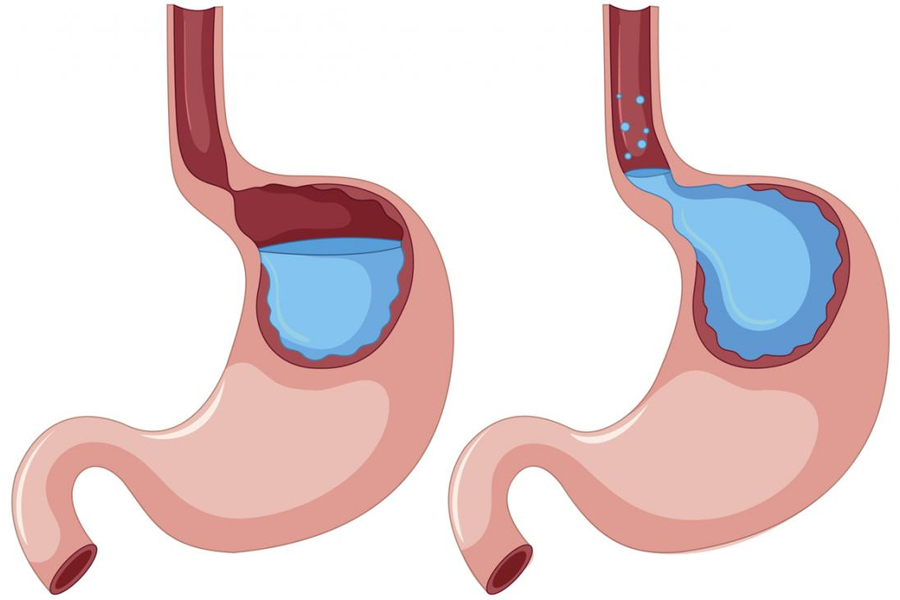GASTROESOPHAGEAL REFLUX DISEASE
Laparscopic sleeve gastrectomy
Fast facts on GERD
Here are some key points about GERD. More detail and supporting information is in the main article.
Stomach acid that washes up into the esophagus can cause dangerous tissue damage.
GERD may result from a dysfunctional sphincter (valve) at the top of the stomach and bottom of the esophagus.
Maintaining a healthy weight, quitting smoking, and reducing stress can help reduce the risk of GERD.
Treating GERD may involve the use of protein pump inhibitors, antacids, and other medications, as well as lifestyle changes.
What is GERD?
Gastroesophageal reflux disease is a condition where stomach acid persistently and regularly flows up into the esophagus. The esophagus may also be referred to as the food pipe or gullet, and is the tube that transports food from the mouth to the stomach.
Acid in the esophagus causes heartburn and other symptoms, as well as possible tissue damage.
The American College of Gastroenterology says that at least 15 million Americans experience heartburn - the symptom of acid reflux - every day.
What causes GERD?
Occasional acid reflux is quite common, often occurring as a result of overeating, lying down after eating, or eating particular foods. The American College of Gastroenterology estimates that around 60 million Americans experience the heartburn of acid reflux at least once a month.

If the sphincter at the top of the stomach does not close properly, stomach contents can flow upward.
However, recurrent acid reflux, diagnosed as GERD, typically has other causes and risk factors
and can have more serious complications.
Gastroesophageal reflux disease occurs in people of all ages, sometimes for unknown reasons (idiopathic).
In short, GERD occurs when the sphincter at the bottom of the esophagus becomes weak, or opens when it shouldn't.
GERD occurs more commonly in people who are:
Overweight or obese - because of increased pressure on the abdomen.
Pregnant - for the same reason as above.
Taking certain medications - including some asthma medications, calcium channel blockers,
antihistamines, sedatives, and antidepressants.
Smoking - and exposure to second-hand smoke. Hiatal hernia is a condition where an opening in the diaphragm lets the top of the stomach move up into the chest; this lowers the pressure in the esophageal sphincter and raises the risk of GERD.
Signs and symptoms of GERD
The main symptom of GERD is heartburn - a discomfort felt behind the breastbone that takes the form of a burning sensation. It tends to worsen if the person lies down or bends over, and also after eating food.
However, not all people with GERD experience heartburn, and there are other possible symptoms:
nausea or vomiting
bad breath
respiratory problems
difficulty or pain when swallowing
wearing away of the teeth
Complications of GERD
Esophagitis -inflammation of the esophagus.
Esophageal stricture - the esophagus becomes narrow, making it difficult to swallow.
Barrett's esophagus - the cells lining the esophagus change into cells similar to the lining of the intestine. This can develop into cancer.
Respiratory problems - it is possible to breathe stomach acid into the lungs, which can cause a range of problems including chest congestion, hoarseness, asthma, laryngitis, and pneumonia.
Tests and diagnosis of GERD
Anyone who is experiencing frequent acid reflux symptoms should talk first to their doctor, who may refer them to a specialist in gut medicine (a gastroenterologist) for further investigation.
There are several possible tests to diagnose GERD:
Esophageal pH and impedance monitoring - measures the amount of acid in the esophagus while, for instance, eating or sleeping.
Upper gastrointestinal (GI) endoscope - a tube with a camera attached is used to inspect the esophagus. A small sample of tissue (biopsy) may also be taken at the same time.
Upper GI series - a type of X-ray that shows up certain physical abnormalities that might cause GERD.
Esophageal manometry - measures muscle contractions in the esophagus during swallowing. It can tell how strong the sphincter is.
Bravo wireless esophageal pH monitoring - a small temporary capsule is attached to the esophagus. This measures the acidity constantly for around 48 hours.
Treatment and prevention of GERD
Proton pump inhibitors - these are one of the two main pharmaceutical treatment options for people with GERD. They decrease the amount of stomach acid that is produced.
H2 blockers - these are another option to help decrease acid production.
Antacids - these counteract the acid in the stomach with alkaline chemicals. Side effects can include diarrhea and constipation.
Prokinetics - these help the stomach empty faster. Side effects include diarrhea, nausea, and anxiety.
Erythromycin - a type of antibiotic; it also helps the stomach empty quicker.
Other lifestyle and behaviour changes can help relieve GERD and its symptoms:
do not overeat
avoid trigger foods such as spicy, acidic, or greasy foods
stop eating 2-3 hours before sleeping
stop smoking
lose weight if overweight
do not wear clothing that is tight around the abdomen
sleep at a slight angle with the head slightly elevated
Foods to avoid with GERD
Certain foods may trigger GERD's symptoms in some people; these include:
greasy foods
spicy foods
chocolate
peppermint
Coffe
foods with tomato products
alcoholic drinks
Surgical options for GERD
If lifestyle changes do not significantly improve the symptoms of GERD, there are surgical options:
Fundoplication - the surgeon sews the top of the stomach around the esophagus; this adds pressure to the lower end of the esophagus and is generally successful at reducing reflux.
Endoscopic procedures - these include endoscopic sewing, which uses stitches to tighten the sphincter muscle. And, radiofrequency, which uses heat to produce small burns that help tighten the sphincter muscle.